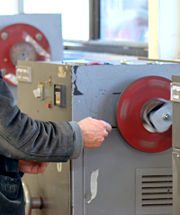.gif)
Winder (machine)
Encyclopedia

Bobbin
A bobbin is a spindle or cylinder, with or without flanges, on which wire, yarn, thread or film is wound. Bobbins are typically found in sewing machines, cameras, and within electronic equipment....
, reel, etc.
In textiles
Winders are used heavily in textile manufacturingTextile manufacturing
Textile manufacturing is a major industry. It is based in the conversion of three types of fibre into yarn, then fabric, then textiles. These are then fabricated into clothes or other artifacts. Cotton remains the most important natural fibre, so is treated in depth...
, especially in preparation to weaving
Weaving
Weaving is a method of fabric production in which two distinct sets of yarns or threads are interlaced at right angles to form a fabric or cloth. The other methods are knitting, lace making and felting. The longitudinal threads are called the warp and the lateral threads are the weft or filling...
where the yarn is wound onto a bobbin and then used in a shuttle
Shuttle (weaving)
A shuttle is a tool designed to neatly and compactly store weft yarn while weaving. Shuttles are thrown or passed back and forth through the shed, between the yarn threads of the warp in order to weave in the weft....
. Ball winders are another type of winder that wind the yarn up from skein
Skein
Skein may refer to:* A flock of geese or ducks in V formation flight* A wound ball of yarn with a center pull strand, see hank* TV Series, used part of Variety's slanguage.* Skein dubh, a Scottish knife* Skein module, a mathematical concept...
form into balls. Ball winders are commonly used by knitters
Knitting
Knitting is a method by which thread or yarn may be turned into cloth or other fine crafts. Knitted fabric consists of consecutive rows of loops, called stitches. As each row progresses, a new loop is pulled through an existing loop. The active stitches are held on a needle until another loop can...
and occasionally spinners
Spinning (textiles)
Spinning is a major industry. It is part of the textile manufacturing process where three types of fibre are converted into yarn, then fabric, then textiles. The textiles are then fabricated into clothes or other artifacts. There are three industrial processes available to spin yarn, and a...
.
Mechanized winders
Winders have a center roll (a bobbin, spool, reel, belt-winding shell, etc.) on which the material is wound up. Often there are metal bars that travel through the center of the roll, and are shaped according to their intended purpose. A circular bar facilitates greater speed, while a square bar provides a greater potential for torque. Edge sensors are used to sense how full the center roll is. They are mounted on adjustable slides to accommodate many different widths, as the width increases as the center roll is filled. The sensitivity of the sensor depends on the required speed of operation.Types of winding machine
Winding machines are classified based on the materials they are winding, some major types are- Coil winding machine
- Film winding machine
- Rope winding machine
- Paper winding machine
- Foil winding machine
On the basis of working the winders are classified as follows
- Shaft or shaft-less winding machine
- Cantilevered turret winding machine
- Carriage style winding machine
Automatic splice initiation
The benefits of automatic splicing add up to significantly increased productivity, greater quality control and reduced waste. It consists of a tail grabber and automatic diameter calculated splice initiation technique. The precision shear wheel and anvil mechanism guarantees a clean cut and no overlap. The splicing technique is divided in to two major categories based on the type of joint, they are, Butt splicing where adhesives are used and Lap splicing:lap joint by means of applying heat and pressing it.Web break detection
Some winders have sensors built in to monitor the web (thread, wire, etc. that is being wound). There are three common types of sensors:- Fiber optic IR measurement sensors
- Contact optic sensors
- Non-contact optic sensors
An optical sensor is placed above or under the web to be controlled. Standard sensors are not affected by dirt, steam or temperatures up to 160 degrees Celsius. Optical sensors work by sending a beam of light at the web, and seeing if the light is reflected or not.

